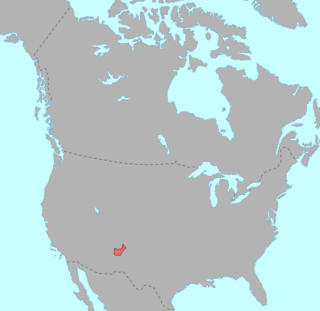Related Research Articles

Joseph Harold Greenberg was an American linguist, known mainly for his work concerning linguistic typology and the genetic classification of languages.
Mobilian Jargon was a pidgin used as a lingua franca among Native American groups living along the Gulf of Mexico around the time of European settlement of the region. It was the main language among Native tribes in this area, mainly Louisiana. There is evidence indicating its existence as early as the late 17th to early 18th century. The Native groups that are said to have used it were the Alabama, Apalachee, Biloxi, Chacato, Pakana, Pascagoula, Taensa, Tunica, Caddo, Chickasaw, Houma, Choctaw, Chitimacha, Natchez, and Ofo. The name is thought to refer to the Mobile Indians of the central Gulf Coast, but did not originate from this group; Mobilian Jargon is linguistically and grammatically different from the language traditionally spoken by the Mobile Indians.

Uto-Aztecan, Uto-Aztekan is a family of indigenous languages of the Americas, consisting of over thirty languages. Uto-Aztecan languages are found almost entirely in the Western United States and Mexico. The name of the language family was created to show that it includes both the Ute language of Utah and the Nahuan languages of Mexico.

Muskogean is a Native American language family spoken in different areas of the Southeastern United States. Though the debate concerning their interrelationships is ongoing, the Muskogean languages are generally divided into two branches, Eastern Muskogean and Western Muskogean. Typologically, Muskogean languages are agglutinative. One documented language, Apalachee, is extinct and the remaining languages are critically endangered.

Alabama, also known as Alibamu, is a Native American language, spoken by the Alabama-Coushatta tribe of Texas. It was once spoken by the Alabama-Quassarte Tribal Town of Oklahoma, but there are no more Alabama speakers in Oklahoma. It is a Muskogean language, and is believed to have been related to the Muklasa and Tuskegee languages, which are no longer extant. Alabama is closely related to Koasati and Apalachee, and more distantly to other Muskogean languages like Hitchiti, Chickasaw and Choctaw.

Koasati is a Native American language of Muskogean origin. The language is spoken by the Coushatta people, most of whom live in Allen Parish north of the town of Elton, Louisiana, though a smaller number share a reservation near Livingston, Texas, with the Alabama people. In 1991, linguist Geoffrey Kimball estimated the number of speakers of the language at around 400 people, of whom approximately 350 live in Louisiana. The exact number of current speakers is unclear, but Coushatta Tribe officials claim that most tribe members over 20 speak Koasati. In 2007, the Coushatta Tribe of Louisiana, in collaboration with McNeese State University and the College of William and Mary, began the Koasati (Coushatta) Language Project as a part of broader language revitalization efforts with National Science Foundation grant money under the Documenting Endangered Languages program.

Keres, also Keresan, is a Native American language, spoken by the Keres Pueblo people in New Mexico. Depending on the analysis, Keres is considered a small language family or a language isolate with several dialects. The varieties of each of the seven Keres pueblos are mutually intelligible with its closest neighbors. There are significant differences between the Western and Eastern groups, which are sometimes counted as separate languages.

Mary Rosamond Haas was an American linguist who specialized in North American Indian languages, Thai, and historical linguistics. She served as president of the Linguistic Society of America. She was elected a fellow of the American Academy of Arts and Sciences and a member of the National Academy of Sciences.
Mescalero-Chiricahua is a Southern Athabaskan language spoken by the Chiricahua and Mescalero people in Chihuahua and Sonora, México and in Oklahoma and New Mexico. It is related to Navajo and Western Apache and has been described in great detail by the anthropological linguist Harry Hoijer (1904–1976), especially in Hoijer & Opler (1938) and Hoijer (1946). Hoijer & Opler's Chiricahua and Mescalero Apache Texts, including a grammatical sketch and traditional religious and secular stories, has been converted into an online "book" available from the University of Virginia.
Harry Hoijer was a linguist and anthropologist who worked on primarily Athabaskan languages and culture. He additionally documented the Tonkawa language, which is now extinct. Hoijer's few works make up the bulk of material on this language. Hoijer was a student of Edward Sapir.

Atakapa is an extinct language isolate native to southwestern Louisiana and nearby coastal eastern Texas. It was spoken by the Atakapa people. The language became extinct in the early 20th century.
The Yamasees were a multiethnic confederation of Native Americans who lived in the coastal region of present-day northern coastal Georgia near the Savannah River and later in northeastern Florida. The Yamasees engaged in revolts and wars with other native groups and Europeans living in North America, specifically from Florida to North Carolina.

The Coushatta are a Muskogean-speaking Native American people now living primarily in the U.S. states of Louisiana, Oklahoma, and Texas.

The Natchez language is the ancestral language of the Natchez people who historically inhabited Mississippi and Louisiana, and who now mostly live among the Muscogee and Cherokee peoples in Oklahoma. The language is considered to be either unrelated to other indigenous languages of the Americas or distantly related to the Muskogean languages.
Itzaʼ is an endangered Mayan language spoken by the Itza people near Lake Peten Itza in north-central Guatemala and neighboring Belize. The language has about 1,000 fluent speakers, all older adults.

The International Journal of American Linguistics (IJAL) is an academic journal devoted to the study of the indigenous languages of the Americas. IJAL focuses on the investigation of linguistic data and the presentation of grammatical fragments and other documents relevant to Amerindian languages.
Klamath, also Klamath–Modoc and historically Lutuamian, is a Native American language spoken around Klamath Lake in what is now southern Oregon and northern California. It is the traditional language of the Klamath and Modoc peoples, each of whom spoke a dialect of the language. By 1998, only one native speaker remained, and by 2003, this last fluent Klamath speaker who was living in Chiloquin, Oregon, was 92 years old. As of 2006 there were no fluent native speakers of either the Klamath or Modoc dialects; however, as of 2019, revitalization efforts are underway with the goal of creating new speakers.
The Gulf languages are a proposed family of native North American languages composed of the Muskogean languages, along with four language isolates: Natchez, Tunica, Atakapa, and (possibly) Chitimacha.
Macro-Mayan is a proposal linking the clearly established Mayan family with neighboring families that show similarities to Mayan. The term was apparently coined by McQuown (1942), but suggestions for historical relationships relevant to this hypothesis can be traced back to the Squier (1861), who offered comparisons between Mayan and Mixe-Zoquean languages, and Radin, who did the same for Mixe-Zoquean, Huave, and Mayan.
Houma is a Western Muskogean language that was spoken in the Central and Lower Mississippi Valley by the indigenous Houma people. There are currently no native speakers; however, efforts continue to bring the Houma language back to its people through a group of dedicated Houma persons and linguists, the Houma Language Project.
References
- ↑ Broadwell, George A. (1992). Reconstructing Proto-Muskogean Language and Prehistory: Preliminary results. 3, en. 2. CiteSeerX 10.1.1.72.4700 .
- ↑ Kimball, Geoffrey (April 1987). "A Grammatical Sketch of Apalachee". International Journal of American Linguistics. 53 (2). University of Chicago Press: 136–174. doi:10.1086/466050. JSTOR 1265142.
- ↑ Kimball, Geoffrey (October 1988). "An Apalachee Vocabulary". International Journal of American Linguistics. 54 (4). University of Chicago Press: 387–398. doi:10.1086/466093. JSTOR 1265100.
- ↑ Haas, Mary R. (April 1949). "The Position of Apalachee in the Muskogean Family". International Journal of American Linguistics. 15 (2). University of Chicago Press: 121–127. doi:10.1086/464031.